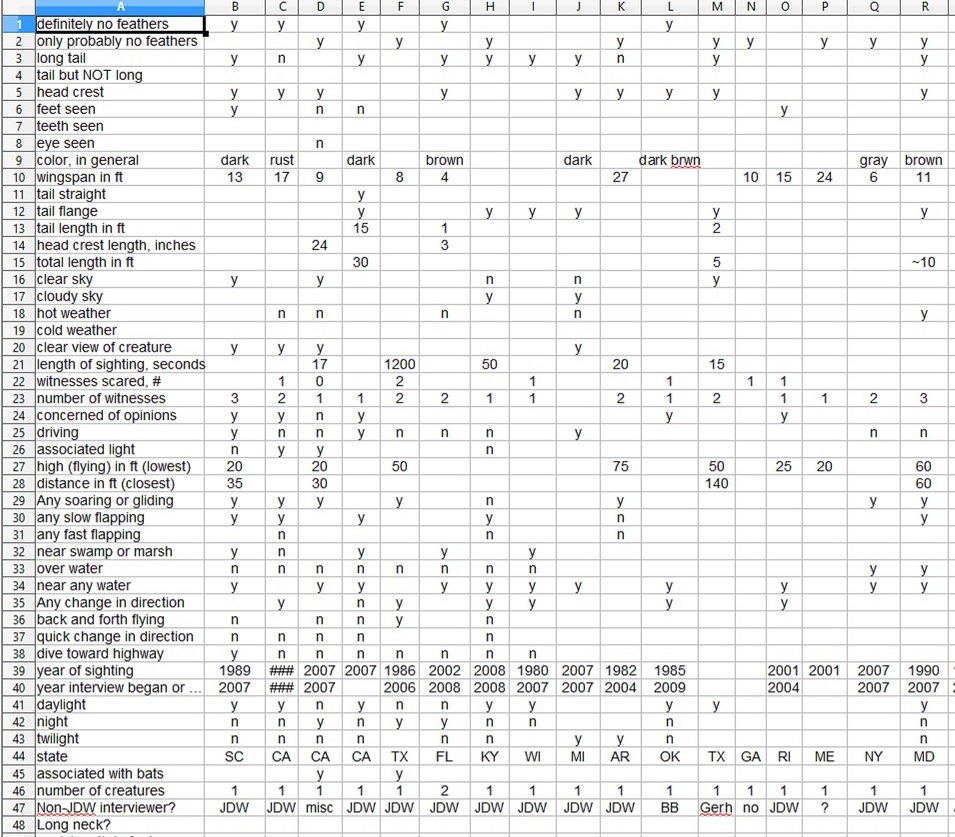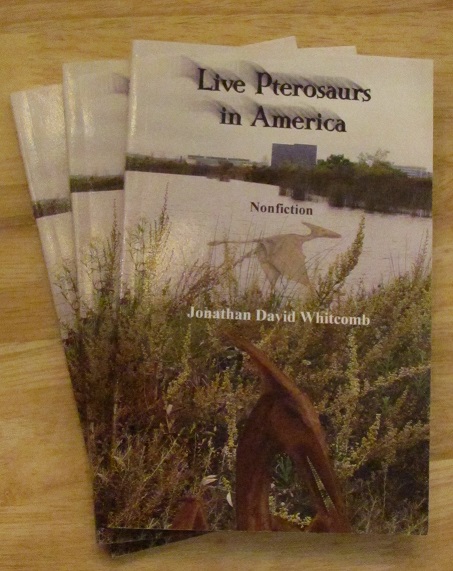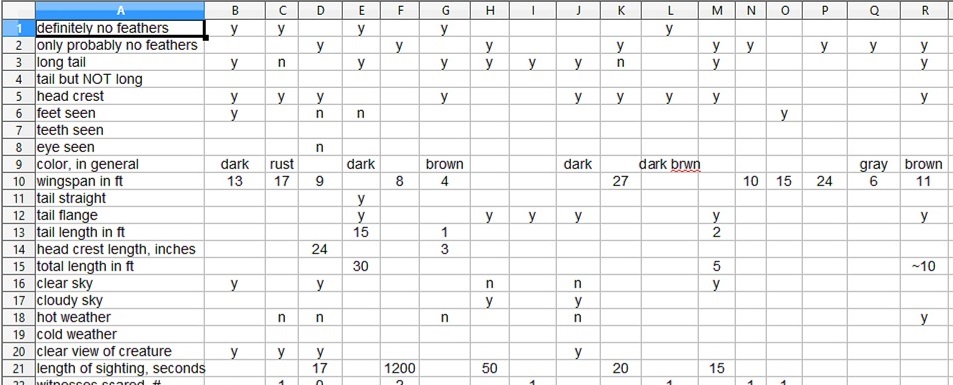I now make my pterosaur-sightings data available to the public, from the compilations leading up to the end of 2012, for the forty-eight contiguous states of the USA, for the more credible reports. Out of the 128 sightings (worldwide) in that compilation, 90 were in the lower-forty-eight states. For details on those sightings in the USA, see these images (Be aware that the first one, with columns B-U, is the only image designating, on the left, the kind of data):
Pterosaur Sightings – columns B through U
(CA, TX, IN, SC, FL, KY, WI, MI, AR, OK, GA, RI, ME, NY, MD, KS)
.
Pterosaur Sightings – columns V through AN
(OH, CA, GA, TX, NM, WA, PA, MI, WI)
.
Pterosaur Sightings – columns AO through AZ
(TX, CA, KY, AZ, FL, GA)
.
Pterosaur Sightings – columns BA through BL
(NY, PA, NJ, GA, MI, NC, OR, WA)
.
Pterosaur Sightings – columns BM through BW
(CA, MN, WA, MT, ID, SC, AR, MS, NC, KS)
.
Pterosaur Sightings – columns BX through CM
(GA, VA, CA, NC, OK, NY, IL, LA, WA, AL, AZ, FL)
Be aware that five of the above can be understood only by referencing the top one, which contains an explanation in the “A” column for the kind of information: “long tail” (yes of no), length of sighting (in seconds), etc.
.
Introduction to the Data on American Pterosaur Sightings
Except for column-A, each column is for a sighting report in the United States of America (NOT including Alaska and Hawaii). Column-A is the type of data, for example row-3 is for the presence or absence of a long tail. Many of the cells are empty, for most eyewitnesses gave limited information on their encounters.
What do I mean by “more credible sightings?” Each sighting report in this compilation (including the 90 here examined) was judged by me to be more than 50% likely to have been an actual encounter with a living pterosaur.
In what state was a particular sighting? Row-44 tells you that, usually in the two-letter abbreviation used by the U.S. Postal Service.
What do I mean by “Non-JDW interviewer?” Row-47 tells who interviewed an eyewitness. I’m JDW (Jonathan David Whitcomb), and “JDW+” means I was one of the interviewers. I interviewed eyewitnesses in at least 64 of the 90 sightings (71%+).
What do I mean by “Concerned of opinions?” Row-24 is for indications of whether or not an eyewitness was worried about what people would think about their reporting a sighting of an apparent “pterodactyl” or “dragon” (by whatever name). For 75 of those 90 reports, I did not get anything recorded in the database, but 14 indicated they were concerned and one indicated no concern. In light of the 14-to-1 ratio, I feel sure that the great majority of the remaining 75 did indeed worry about what other people would think about them.
In What States Were the Sightings?
The following shows how many sightings were in the 33 states involved.
Alabama: 1
Arizona: 2
Arkansas: 2
California: 13
Florida: 3
Georgia: 7
Idaho: 1
Illinois: 1
Indiana: 2
Kansas: 2
Kentucky: 2
Louisiana: 1
Maine: 1
Maryland: 1
Michigan: 2
Minnesota: 1
Mississippi: 1
Missouri: 1
Montana: 1
New Jersey: 2
New Mexico: 2
New York: 5
North Carolina: 4
Ohio: 3
Oklahoma: 2
Oregon: 1
Pennsylvania: 3
Rhode Island: 1
South Carolina: 2
Texas: 10
Virginia: 2
Washington: 6
Wisconsin: 2
.
Notice that in the two states with the largest human populations (California and Texas) we have more sightings (13 and 10) than in other states and that these are also the two largest states in land area (48-contiguous states). The third-place award for most sighting reports is Georgia, with seven. This state is average in land area but large in human population, eighth in the United States according to a July-2014 estimate.
Why so Long in Coming?
Why has it taken so long for this pterosaur-sighting data to be made public? I compiled it at the end of 2012 and made certain statistical data available in 2013. But I saw that it would be too easy for many persons to jump to wrong conclusions, if they had all the raw data. At least one or two prospective armchair researchers were actually expecting to learn something about migratory patterns from the many details that I had compiled on encounters with apparent pterosaurs in the forty-eight contiguous states of the USA.
But what can anybody learn about migration patterns from a teenaged girl who throws a few stones over the edge of a cliff, causing a “pterodactyl” to fly off the edge of that cliff and glide away down the river gorge? The direction of flight has no relationship to any migratory pattern, for that flying creature was just trying to avoid getting hit by a flying rock. You might as well take note in which direction a running back is running with a football and try to figure out in what city he’ll be playing the next game, next week.
.
Image of the Kinds of Data

.
###
.
Pterosaur Sighting by a Ms Wooten, in South Carolina
Susan Wooten, of Greenville, South Carolina, was driving from home to Florence (about 1989) when she saw a giant creature glide over the highway in front of the car. . . . “It looked as big as any car, and had NO feathers, not like a huge crane or egret”
Pterosaur Sightings in North America
What about sighting reports? Can’t they help us understand migration for these featherless flying creatures? Not likely. Look at a few examples. A teenager and her dad are standing at the top of a cliff as the girl is tossing stones over the edge. A large “pterodactyl” flies off the cliff, just below the humans, soaring out over the river below. The flight direction has nothing to do with any migration . . .
American Pterosaur Sightings (and in Papua New Guinea)
From 2005 until the present, eyewitness reports in the United States have rivaled those in Papua New Guinea. As some Americans learned about the live-pterosaur investigations in the Southwest Pacific, eyewitnesses of similar flying creatures reported encounters to Jonathan Whitcomb; he analyzed the many accounts and then wrote the non-fiction book Live Pterosaurs in America . . .
California Pterosaur Sightings (Los Angeles)
The sightings were a little over a mile apart, both from drivers on the northbound Interstate-5 Freeway, just east of Griffith Park, near Glendale.
What does Texas have to do with extant pterosaurs? A lot. Not only do eyewitnesses report apparent living pterosaurs in Texas, but two Texans are pioneers in this cryptozoological investigation.
This past Wednesday, January 2, 2013, I received an email from an eyewitness in Missouri. The sighting was not old: “about 45 minutes ago.” But the present hot spot for sightings, in the past few weeks of cooler weather, is the state of Georgia, with two sightings in December of 2012.
.
_________________________________________________________

Cryptozoology book Live Pterosaurs in America
From the back cover of this nonfiction:
The author, Jonathan Whitcomb, the world’s most prolific writer on living pterosaurs, here shares with you years of interviews with Americans who have encountered the rare nocturnal flying creatures whose descriptions make them nothing other than pterosaurs . . .
.




3 Replies to “New to the Public: Sightings Data for USA”
Comments are closed.